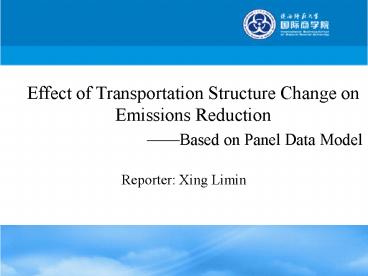Effect of Transportation Structure Change on Emissions Reduction
1 / 12
Title:
Effect of Transportation Structure Change on Emissions Reduction
Description:
Effect of Transportation Structure Change on Emissions Reduction Based on Panel Data Model Reporter: Xing Limin Outline Introduction Panel Data Model Results ... –
Number of Views:74
Avg rating:3.0/5.0
Title: Effect of Transportation Structure Change on Emissions Reduction
1
Effect of Transportation Structure Change on
Emissions Reduction
Based on Panel Data Model
- Reporter Xing Limin
2
Outline
- Introduction
- Panel Data Model
- Results and Discussion
- Conclusion
3
- Introduction Backgrounds
- Vehicle emissions have become important driving
force for haze weather in China. - In 2013, 20--30 PM2.5 in Beijing was produced
by tail gas of motor vehicle. Institute of
Atomospheric Physics, Chinese Academy of Sciences - Energy consumption and CO2 in transport
increase rapidly in past 20 years. - Highway play a dominant role in turnover and
CO2emissions. - Transport structure oriented emission reduction
policy in other countries can provide experience
for China. - America, Europe, Japan
4
Introduction Literature
- About transport carbon reduction, most authors
research on energy price adjustment, technique
improvement , tax policy. - Few literature on the effect of transport
structure change on CO2 reduction. - Eg. Wei Qingqi et al(2014) built VEC model,
concluded that traffic structure optimization has
long term influence on energy intensity decrease. - Disadvantage the quantitative relationship
between structure change and CO2 reduction is
not established.
5
Panel Data Model Variables and Data
- Independent Variables X1,X2,X3,X4 respectively
stand for percentage of highway, railway,
waterage (ocean carriage excluded) and civil
aviation (international transport excluded). - Dependent Variables Y stands for CO2 emissions/
converted turnover. - Cross section of the individual U.S., Europe,
Japan, China. - Data Resource Passenger- freight transport
turnover come from Transport Statistical
Yearbook, CO2 emissions come from World Bank
Database. All the data are from 1990-2011.
6
Panel Data Model Stationarity Test
- X1,X2,X3,X4,Y
- first difference
- series are stable
7
Panel Data Model Cointegration Test
- Johansen cointegration test.
- Show that there is a long term balanced
relation between transport structure and
CO2/converted turnover.
8
Panel Data Model Model Building
- Based on Hausman test and F test, fixed effect
and variable coefficient model is determined.
(1)
China U.S. Europe Japan
9
Panel Data Model Model Building
- imply the first difference
value of percent of highway, railway, waterage
and civil aviation turnover. - signify the first difference value of carbon
emissions /converted turnover. - i1,2,3,4. respectively stand for China, U.S.,
Europe, Japan from up to down in the Eq(1). - stand for when
increase/decrease 1,the amount of CO2
will change.
10
Results and Discussion
- 1 change of highway percent would lead
to increase at CO2 / converted turnover by 4.44,
2.46 , 3.47,-1.77 in U.S., Europe, Japan and
China. - are all negative . Railway percent
CO2 / converted turnover
(Japanmax-3.63,Chinamin-0.38). - negative. Waterage percent CO2
/ converted turnover (Europemax-22.11,China-0.
056,U.S.0.805,Japan-0.093) - positive. civil aviation percent
CO2 / converted turnover - (Japan U.S., China ,Europe.
149.67,54.99,54.53,-27.07)
11
Conclusions
- Long term balanced relation existes between
transport structure and carbon emission
performance. - Increase in the share of waterage and railway
will lead to traffic carbon emissions reduction.
Besides, the influence degree is quite varied due
to different transport structure in different
countries ,and different carbon emission
performance of different traffic ways.
12
- Thanks!































